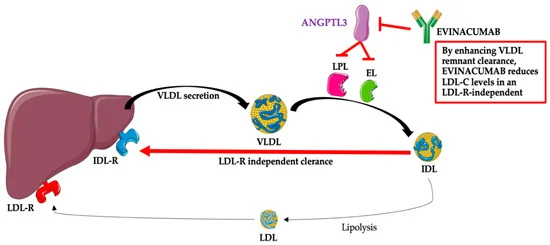Transport of lipids, role of lipoproteins, structure of lipoprotein particles. Formation, conversion, and role of chylomicrons, VLDL, LDL and HDL lipoproteins
Lipoproteins are complex particles made up of lipids (fats) and proteins that function to transport lipids, such as cholesterol, triglycerides, and phospholipids, through the bloodstream. Since lipids are not water-soluble, lipoproteins act as carriers that facilitate their transport in the aqueous environment that is the bloodstream. Their protein component is apolipoproteins which support lipoproteins structurally as well as act as recognition molecules for certain receptors on cell surfaces and assist in binding.
Structure of Lipoprotein
Hydrophilic Shell
The outer shell of a lipoprotein must be hydrophilic and is therefore composed of a single layer of phospholipids woth their hydrophilic heads pointing outwards and their tails to the core of the lipoprotein. Unesterfified cholesterol is also imbedded in this shell between the phospholipids. The protein component of lipoproteins is the apolipoproteins, also imbedded in the surface or attached to the lipid layer. These proteins have several functions including: stabilise the structure of the lipoprotein, binding to receptors on different cells depending on their type, and some act as cofactors for certain enzymes involved in lipid metabolism.
Hydrophobic Core
The inner core is composed of triglycerides; they are the main form for storing energy. Triglycerides consist of three fatty acid chains esterified to a glycerol backbone. The core also contains cholesterol molecules bound to fatty acids referred to as cholesterol esters. Both are hydrophobic which is why they are found in the core of the lipoprotein.
Classes of Lipoproteins
Types of Lipoproteins in our body have distinct functions - the density refers to the amount of protein
- Chylomicrons
- VLDL - very low density lipoprotein
- IDL - Intermediate density lipoprotein
- LDL - Low density lipoprotein
- HDL - High density lipoprotein
| Chylomicron | VLDL | LDL | HDL | |
|---|---|---|---|---|
| TAG | 90% | 60% | 10% | 5% |
| Phospholipids | 4% | 17.5% | 20% | 30% |
| Cholesterol | 5% | 12.5% | 45% | 20% |
| Proteins | 1% | 10% | 25% | 35% |
Chylomicrons
Chylomicrons are the largest in diameter of all lipoproteins. They are mostly composed of triglycerides and form in intestinal mucosal cells. Their triglycerides originate from our diet, which they carry to peripheral tissue. Inside the enterocytes, the monoglycerides and fatty acids which are absorbed from the diet are re-esterified into triglycerides and packaged with cholesterol, phospholipids, and apolipoproteins to form chylomicrons. Once assembled, chylomicrons are uptaken by lacteals then enter the lymphatic vessels. They enter the blood stream through the thoracic duct.
When encountering adipose tissue, they deposit fatty acids in fat cells. On fat cells there is an extracellular enzyme, lipoprotein lipase, anchored to the cell walls of capillary walls of adipose tissue, cardiac, and skeletal muscle tissue. Lipoprotein lipase is activated by apoprotein C-II of chylomicrons which hydrolyzes the TAGs contained in chylomicrons to yield fatty acids and glycerol. Fatty acids can now be stored by the adipose tissue or used for energy by the muscle tissue (cardiac or skeletal).
- Cardiac lipoprotein lipase has a low Km for triacylglycerols, about 1/10 Km of adipose tissue enzymes. This allows in the case of starvation, when the plasma concentration of triacylglycerols is low, the energy in the form of FFA is preferentially used in the myocardium.
- Remnant chylomicron are taken up from the circulation by hepatocytes by receptor- mediated endocytosis. The receptors are LDL receptor-related protein or ApoE receptor.
VLDL

Very low density lipoproteins mostly have a content of triglycerides and are responsible for transporting liver-synthesized triglycerides to various tissues. They are formed in hepatocytes. In hepatocytes, acetyl CoA from pyruvate oxidation in the smooth endoplasmic reticulum is used to make cholesterol. Also DHAP from glycolysis can be used to make glycerol and from fatty acids we can make Triglycerides all of which are packaged in VLDL. The major apolipoprotein on VLDLs is B-100; it acts as a ligand for an LDL receptor on hepatocytes which makes clearnace of the blood from LDL remnants possible. VLDL also interact with circulating HDL to acquire more lipoproteins such as Apo C-II and Apo-E.
As it passes through circulation it encounters LPL (lipoprotein lipase) to hydrolyze TAGs. Free fatty acids enter the tissue. It is now known as IDL, intermediate density lipoproteins. In the blood it encounters HDL and gives it TAGS and obtains cholesterol from HDL, so it is now known as LDL due to higher levels of cholesterol and low TAGs.
LDL
Low density lipoproteins contain a higher proportion of cholesterol relative to triglycerides. They are the primary carriers of cholesterol to tissues, including the heart and arteries. They form from VLDL as it loses triglycerides to the tissue which makes it smaller and denser, forming IDL. Intermediate density lipoprotein can then either be uptaken by the liver or lose additionaly triglycerides forming LDL in the bloodstream. It is more enriched with cholesterol as TAGs are lost, making it smaller and denser. The primary apolipoprotein in LDL is Apolipoprotein B-100 (ApoB-100), which facilitates LDL receptor binding on cells, allowing LDL to deliver cholesterol to tissues.
Low density lipoprotein carries cholesterol to the testes or adrenal cortex to generate steroid hormones from cholesterol. The testes generate testosterone. This is via LDL receptors. It transports cholesterol to peripheral tissue and is then recycled by the liver.
HDL
high density lipoproteins have the smallest diameter and highest proportion of proteins. This is why it is a reservoir of apolipoproteins, can uptake unesterified cholesterol, helps in esterification of cholesterol, and takes part in reverse cholesterol transport (by removing accumulating cholesterol - good cholesterol). They are a reservoir of Apo C-II (lipoprotein that is transferred to VLDL and Chylomicrons and is an activator of lipoprotein lipase). They are a reservoir for Apo E (the Apolipoprotein required for the receptor mediated endocytosis of IDL’s and chylomicron remnants).






